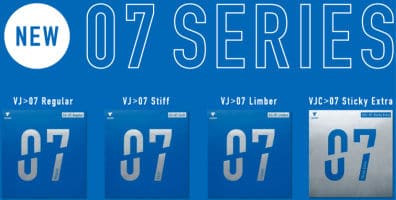
Victas released a new series of rubbers in 2019, called the VJ series. The VJ > 07 Limber, Regular and Stiff are made in Japan, the VJC is a combined Japan / China effort. This article reviews each rubber in detail, provides comparisons to other popular rubbers, and includes a summary of the player’s style and level that they’re suitable for.
Review by Paton Wilson
Packaging/Initial Observations
Obtaining the rubbers, each rubber’s packaging resembled the standard plastic sleeve over a thick paper covering. The three more traditional VJ > 07 series rubbers (Limber, Regular and Stiff) shared a similar design with the V >15 series’ second iteration; with large silver text over a blue background and more detailed information on the backside of the paper. The fourth rubber being the new ‘Sticky Extra’ reversed the colour scheme with blue writing on a silver background which was quite striking. Upon opening, the presentation is clean and the packaging is sharp, with a three fold sleeve and a clean rubber cover page brandishing a motivational slogan consistent with previous Victas products. All rubbers obtained were of MAX thickness and were all from the same distributor.
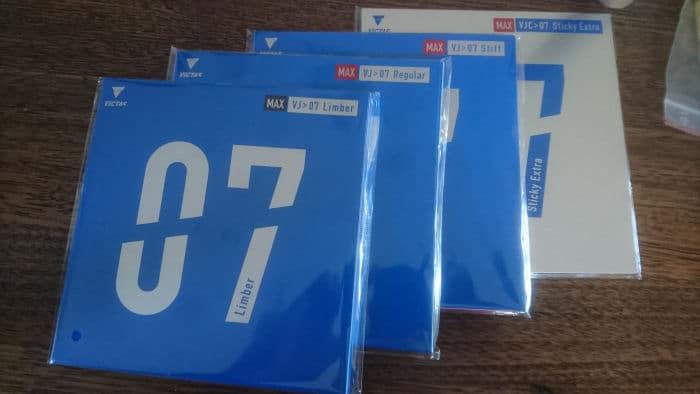
Starting with the Victas VJ > 07 Limber the sponge is a light orange colour and as the name would suggest the sponge and rubber felt very ‘soft’ to the touch, with the packaging claiming the rubber has a sponge hardness of 40. The rubber before being cut weighed a total of 54g. After being cut the rubber weighed a very light 38g.
The Victas VJ > 07 Regular has the same colour sponge weighing in at 53g uncut and felt similar to the Limber with it almost feeling softer to the touch to me with the packaging claiming the rubber has a sponge hardness of 42.5. After being cut the rubber weighed around 37g.
The Victas VJ > 07 Stiff has a red sponge similar to Evolution MX-P or other Tibhar rubbers weighing at 65g uncut and felt much harder and grippier to the touch than both the Regular and the Limber, with the packaging claiming the rubber has a sponge hardness of 45. After being cut the rubber weighed around 46g.
The Victas VJC > 07 Sticky Extra has a cream coloured sponge and weighed 67g uncut. The packaging claimed the Extra sponge hardness comes in at 47.5. The sponge definitely felt harder to the touch than all of the other rubbers in the series, while not as hard as a traditional tacky rubber like Hurricane. The rubber surface itself felt traditionally tacky. After being cut the rubber weighed around 46g.
Test Setup:
My initial setup was using the VJ > 07 Limber on my forehand and VJ > 07 Regular on my backhand on a Yasaka Ma Lin Extra Offensive blade. Having used a similar Limber/Regular combination with Victas V > 15 Extra in the past, I thought this would be a good baseline comparison. Having used the Ma Lin Extra Offensive blade previously for rubber testing, I felt this would be a good, familiar blade to help differentiate and test the rubbers individually as well.
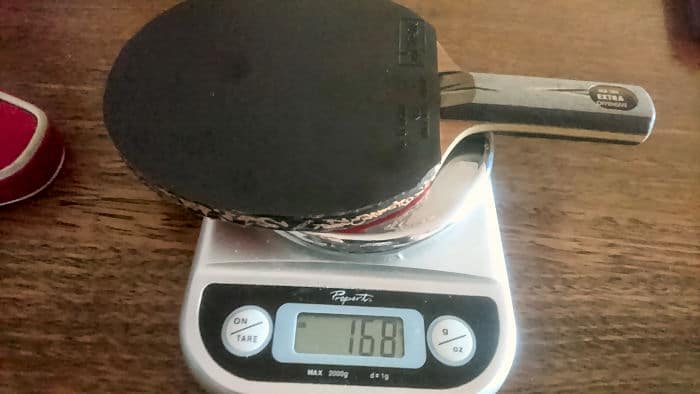
Victas VJ > 07 Limber review
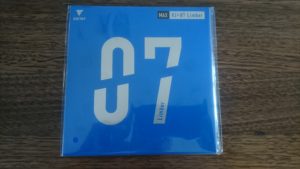 The rubber felt very light on the bat but I didn’t notice a major change to the speed or timing of my strokes when switching from a heavier rubber like MX-P. The most noticeable difference came from the very low throw angle that most shots took and the sheer pace from aggressive hitting. The rubber lends itself well to flat and fast hitting, as is suggested by Victas, with the ball shooting off the bat when pace is applied. What makes this pace so effective is the rubber’s low and direct throw angle, with the ball coming off nearly in a straight line when hit flat. This ensured that I felt confident when hitting aggressively that my shot would go directly to where I aimed it. However the downside of this comes from the difficulty playing spin dominant strokes such as loops, spinning drives or lifting balls off backspin with the Limber. Being used to the slightly/moderately higher throw angles of Donic Bluefire M2 and Tibhar Evolution MX-P, it took me quite some time to adjust to the low throw angle of the Limber when playing spin dominant strokes. The difference in spin generated when comparing the Limber to the VJ > 07 Regular was also very noticeable with pace having to be sacrificed when using the Limber for a similar ‘loop-style’ ball. However after some adjusting to the differences it became noticeable that when timing the ball effectively, low cutting drives are a major weapon the Limber possesses. These aggressive balls held spin while arcing low onto the table and barely bounced as they rocketed off the other side of the table. My training partner commented on the low bounce of the balls coming off the Limber immediately and the difficulty in dealing with such a low ball. The change in the ‘looping style’ to make the rubber effective took some getting used to, but once done so, I was able to execute some quality aggressive balls with both pace and spin. Another advantage of this rubber was its ease to switch between aggressively spun balls and flatter hard hit balls, being able to change weapons mid rally to take advantage during the point.
The rubber felt very light on the bat but I didn’t notice a major change to the speed or timing of my strokes when switching from a heavier rubber like MX-P. The most noticeable difference came from the very low throw angle that most shots took and the sheer pace from aggressive hitting. The rubber lends itself well to flat and fast hitting, as is suggested by Victas, with the ball shooting off the bat when pace is applied. What makes this pace so effective is the rubber’s low and direct throw angle, with the ball coming off nearly in a straight line when hit flat. This ensured that I felt confident when hitting aggressively that my shot would go directly to where I aimed it. However the downside of this comes from the difficulty playing spin dominant strokes such as loops, spinning drives or lifting balls off backspin with the Limber. Being used to the slightly/moderately higher throw angles of Donic Bluefire M2 and Tibhar Evolution MX-P, it took me quite some time to adjust to the low throw angle of the Limber when playing spin dominant strokes. The difference in spin generated when comparing the Limber to the VJ > 07 Regular was also very noticeable with pace having to be sacrificed when using the Limber for a similar ‘loop-style’ ball. However after some adjusting to the differences it became noticeable that when timing the ball effectively, low cutting drives are a major weapon the Limber possesses. These aggressive balls held spin while arcing low onto the table and barely bounced as they rocketed off the other side of the table. My training partner commented on the low bounce of the balls coming off the Limber immediately and the difficulty in dealing with such a low ball. The change in the ‘looping style’ to make the rubber effective took some getting used to, but once done so, I was able to execute some quality aggressive balls with both pace and spin. Another advantage of this rubber was its ease to switch between aggressively spun balls and flatter hard hit balls, being able to change weapons mid rally to take advantage during the point.
The low throw angle of the rubber also made playing backspin strokes very easy. The low throw angle kept the push stroke low without any extra effort so I was able to focus on maximising spin generated as well as depth on the table to maximise the effectiveness of my push. Even playing passive strokes offered the same effect so soft pushes and blocks followed direct low lines and look little effort. Short pushes were a little bit more challenging, only because they required a certain level of ‘care’, while being less careful meant that while the ball wouldn’t pop up, it would go deeper on the table than hoped for. Chopping with the Limber was not impossible, but the low throw angle didn’t leave a lot of safety when chopping aggressively.
On the backhand, looped balls became a little bit easier than on the forehand, but still with a low throw angle, but not nearly as spinny as they were with the Regular. Aggressive drives sometimes bottomed out with pace and sailed off the end of the table, but when executed well enabled a similar type of low drive found on the forehand. Flicks required a bit more grab on the ball when compared with rubbers like Bluefire and MX-P, but could still be executed when timed correctly. The Limber lent itself especially well to backhand punching, with flat hit balls going directly through to their targeted positions with a massive amount of speed. Often punching in my own game, I found this to be quite an appealing aspect of the Limber, as the ball comes off much quicker when compared to a punch from MX-P for example. The pace generated from the punch seemed nearly comparable to a punch from short pimples.
Initial thoughts on the VJ > 07 Regular
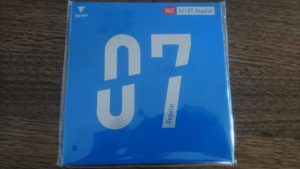 The rubber initially felt quite a bit softer off the bounce when compared with Bluefire and MX-P. After breaking the rubber in a bit it started to bounce off the bat more and felt more lively. When compared with the Limber, the obvious difference was in the rubbers throw angle, which followed a higher arc, similar to Bluefire or Victas V >15 Extra. When spinning the ball, I found a very enticing ‘snap’ at the release of the ball which gave me confidence in my placement and aggression on the ball. As a result of this, I found myself looking for this timing and becoming more aggressive with my own shots. While this rubber didn’t quite have the same pace as the Limber, it offered more flexibility in the spin available for me to use as a weapon in itself. I found that the variability in spin with the Regular offered me just as many points from blocking errors from my opponent as did the Limber hitting shots past my opponent. The rubber was still effective on passive balls such as blocks and softer shots, and the push was still relatively easy to play, although keeping the ball as low took a bit more finesse than with the Limber. The regular could still be effective as a flat hitting weapon as well, just not to the same extent as the Limber.
The rubber initially felt quite a bit softer off the bounce when compared with Bluefire and MX-P. After breaking the rubber in a bit it started to bounce off the bat more and felt more lively. When compared with the Limber, the obvious difference was in the rubbers throw angle, which followed a higher arc, similar to Bluefire or Victas V >15 Extra. When spinning the ball, I found a very enticing ‘snap’ at the release of the ball which gave me confidence in my placement and aggression on the ball. As a result of this, I found myself looking for this timing and becoming more aggressive with my own shots. While this rubber didn’t quite have the same pace as the Limber, it offered more flexibility in the spin available for me to use as a weapon in itself. I found that the variability in spin with the Regular offered me just as many points from blocking errors from my opponent as did the Limber hitting shots past my opponent. The rubber was still effective on passive balls such as blocks and softer shots, and the push was still relatively easy to play, although keeping the ball as low took a bit more finesse than with the Limber. The regular could still be effective as a flat hitting weapon as well, just not to the same extent as the Limber.
Comparing the Limber and Regular in Match play:
Warming up the rubber felt good, although it was coming off both sides of the bat quite hollow sounding. It didn’t take as long for me to adjust to the spin generation of the Limber and counter-hitting came quite naturally. I struggled to push with both rubbers in matches when compared to training, and I feel this is probably because I reverted back to what I was comfortable pushing with for MX-P. There wasn’t a huge noticeable difference in service/spin generation. I definitely found that when hit well, the limber definitely enabled a fast flat winner to be hit.
The regular rubber was effective as well, with loops coming off well and attacking balls having some force to them. Occasionally I found that the ball ‘slid off’ the regular rubber, potentially because of the still softer sponge than what I am used to. I failed to play a few chops, but I feel this was because of poor choice rather than the rubber itself.
There wasn’t a major change to my opinions of the Regular rubber when coaching as I was generally playing passive or softer strokes which didn’t push the rubber. However during a few practice matches on Saturday. After a couple days of use I noticed a distinct change to the rubber’s activeness with a lot of balls ‘slipping off’ (or feeling as if they had) when playing spinny shots off of slower balls or pushes. This feeling reminded me of how some rubbers behave when playing in high humidity, with the grip of the topsheet often becoming slippery and requiring a better contact into the sponge when executing strokes. What perplexed me is that the Limber, although even softer than the Regular, didn’t seem to have the same issue. When playing the same strokes the Limber gave me confidence, whereas I either had to play a different stroke entirely with the Regular, or really make sure I dug into the sponge with the ball, often a difficult thing to do while playing off of softer strokes. Being used to playing with the responsiveness of MX-P, I found it challenging to play with the same intensity using the Regular, especially on my backhand side. When staying close to the table, the Regular worked better, but as soon as I stepped a couple of metres back from the table, I found myself resorting to passive and defensive strokes. On the forehand side, the Regular was a bit more responsive due to the larger and more flexible swing that the forehand enables, but when compared to the Limber or MX-P, I felt like the Regular was not providing me with any distinctive benefit. I decided to test the Regular on a carbon bat and see if having a harder/faster blade would give the Regular some more life.
Using the Regular on a carbon blade (Stiga Offensive Classic Carbon) made a slight change to the pace and amount of time that the ball spent on the rubber. This faster setup helped to fix some of the issues with less of a ‘slipping off’ feeling occurring. It also forced me to take more care in ensuring that I was spinning the ball well on contact, rather than just hitting with spin, otherwise it became quite easy to overplay shots. Overall, I still felt this ‘slipping’ feeling coming into shots and it really swayed my confidence when using the Regular.
While the Regular began to disappoint after some extended use, the Limber on the other hand, has been more and more impressive. After the adjustments to the lower throw angle, I found myself becoming more comfortable looping off of it. I found myself attempting changes in pace in aggressive play and striving for aggressive angles and taking advantage of the low throw. It blocks like a dream and I found myself having more time after a block to set up a counter, rather than having to be more careful with blocks with a more ‘responsive’ rubber. Using it on my forehand has been my preference, but when I switch with it on the backhand, I found myself aggressively punching balls and controlling angles in the rally with less effort. The longer I have played with it the more spin I find coming off the Limber, but still the pace is what really surprises me. When hit through, the ball comes off like a rocket!
Using the Limber in competition really helped to wear in the rubber and it became a lot easier to feel the ball sinking in to the softer sponge. The increase of pace and spin from my opponents also gave me a much better understanding of the changes I needed to make to adjust to the rubber. I found that trying to execute a flat punch return with the Limber without a full stroke resulted in the ball flying into the net, whereas with a harder sponged rubber the ball would normally go in, or at the very least over the net. This lower throw angle also made it challenging to counter hit while further back from the table without sacrificing pace to add spin to the ball. Whereas with a more traditional rubber like the Regular or Extra, the natural higher arc would give me more freedom to hit aggressively. For players who stay closer to the table and hit hard and flat, the Limber is an ideal rubber for you, however if you like to get away from the table and loop, it is not so.
Victas VJ > 07 Stiff Review
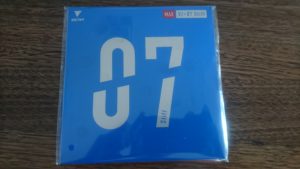 Switching from the regular to the Stiff, I immediately noticed a difference in the responsiveness of the rubber. It felt much more akin to traditional fast rubbers like MX-P and Bluefire, which gave me confidence in my strokes. It worked just as well against slow balls as it did against faster shots, which the Regular did not. Probably the most impressive thing about the Stiff is the rubber’s responsiveness. Not a responsiveness to spin, or pace, or touch but everything. It became very difficult for me to find a downside to using this rubber. After adjusting to the Stiff, I was able to play a whole range of shots effectively, from slow looping balls, to flicks and drives, to passive blocks and pushes short and long. When I found myself back from the table I had security and control to be as aggressive with counter topspin shots, but also had the flexibility to chop and be tactical to defend. Because of the responsiveness, I preferred to use the Stiff on my backhand for aggressive flicking, looping and blocking, I found myself often hitting shots with more precision while still feeling secure and controlled. After using the Stiff for a few weeks, I still had a difficult time finding a downside to the rubber, but I think the responsiveness of the rubber when generating heavy spin shots, leads to having difficulty when needing to increase spin from shot to shot. I would often spin up aggressively and then try to increase spin for the second shot to try and put my opponent under even more pressure and it either worked, I overplayed the shot, or I was unsuccessful at increasing the spin at all. Now, it must be stated that this would only be the case when the first aggressive ball was returned, which did not happen all too often.
Switching from the regular to the Stiff, I immediately noticed a difference in the responsiveness of the rubber. It felt much more akin to traditional fast rubbers like MX-P and Bluefire, which gave me confidence in my strokes. It worked just as well against slow balls as it did against faster shots, which the Regular did not. Probably the most impressive thing about the Stiff is the rubber’s responsiveness. Not a responsiveness to spin, or pace, or touch but everything. It became very difficult for me to find a downside to using this rubber. After adjusting to the Stiff, I was able to play a whole range of shots effectively, from slow looping balls, to flicks and drives, to passive blocks and pushes short and long. When I found myself back from the table I had security and control to be as aggressive with counter topspin shots, but also had the flexibility to chop and be tactical to defend. Because of the responsiveness, I preferred to use the Stiff on my backhand for aggressive flicking, looping and blocking, I found myself often hitting shots with more precision while still feeling secure and controlled. After using the Stiff for a few weeks, I still had a difficult time finding a downside to the rubber, but I think the responsiveness of the rubber when generating heavy spin shots, leads to having difficulty when needing to increase spin from shot to shot. I would often spin up aggressively and then try to increase spin for the second shot to try and put my opponent under even more pressure and it either worked, I overplayed the shot, or I was unsuccessful at increasing the spin at all. Now, it must be stated that this would only be the case when the first aggressive ball was returned, which did not happen all too often.
Victas VJC > 07 Sticky Extra Review
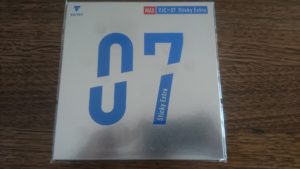 I was interested in trying the new Hybrid rubber from Victas, because I have not had much experience with hybrids so far. I have played with typical/traditional tacky rubbers in the past and can see the appeal, however I have practiced and played so much with European style rubbers that I have trouble getting comfortable. I also have some experience when boosting tacky rubbers to try and liven them up, so I suppose that is as close as I get to hybrid status. Initially the rubber felt less tacky than traditional rubbers such as Hurricane, with only a slight lift on at ball when trying to lift it up with the rubber’s sticky surface. However I definitely noticed the presence of the tackiness when playing shots with it. I found it much easier to adjust to the Sticky Extra when I was using it on my forehand side. I could definitely feel the grip on the ball much more so than the over tested Victas rubbers. However the pace generated from these shots was lacking, when compared to the other rubbers. It is difficult to say that there was more spin generated from the Sticky Extra, compared to the Stiff, but the responsiveness due to the tacky surface was definitely noticeable. When using the Sticky Extra on my backhand, I found that I had to make major adjustments to my stroke to continue to play aggressive well spun shots.
I was interested in trying the new Hybrid rubber from Victas, because I have not had much experience with hybrids so far. I have played with typical/traditional tacky rubbers in the past and can see the appeal, however I have practiced and played so much with European style rubbers that I have trouble getting comfortable. I also have some experience when boosting tacky rubbers to try and liven them up, so I suppose that is as close as I get to hybrid status. Initially the rubber felt less tacky than traditional rubbers such as Hurricane, with only a slight lift on at ball when trying to lift it up with the rubber’s sticky surface. However I definitely noticed the presence of the tackiness when playing shots with it. I found it much easier to adjust to the Sticky Extra when I was using it on my forehand side. I could definitely feel the grip on the ball much more so than the over tested Victas rubbers. However the pace generated from these shots was lacking, when compared to the other rubbers. It is difficult to say that there was more spin generated from the Sticky Extra, compared to the Stiff, but the responsiveness due to the tacky surface was definitely noticeable. When using the Sticky Extra on my backhand, I found that I had to make major adjustments to my stroke to continue to play aggressive well spun shots.
Victas VJ series Summary
Below I will give summary opinions, some positives and negatives and the type of player I believe the rubber would suit.
Victas VJ > 07 Limber
This rubber was a surprisingly versatile and powerful rubber. It continued to impress throughout the testing and set the bar quite high.
Positives
- Very fast rubber when hit hard
- Low throw angle which keeps shots direct
- Easy to push and play passive shots
Negatives
- Difficult to spin/loop aggressively
- Not a lot of ‘give’ when counter hitting
This rubber would be very suitable for players who favor flat-hitting aggressive play over looping and spin dominant play. This rubber would also favor players who play a passive pushing game, waiting for the chance to hit winners off of high returns. The skill level required for this rubber would be intermediate to high, with adjusting to the softer sponge taking some skill.
Victas VJ > 07 Regular
This rubber initially looked quite positive, but over time it had some issues when attempting to play technical/aggressive balls. The feeling of ‘slipping off’ was disconcerting, but when paired with a faster/harder blade, this rubber gains more life and is better to play with.
Positives
- A good balance of spin and power
- Flexible with lots of options
- Very good control in passive play
Negatives
- The ball ‘slips off’ when some aggressive shots are attempted
- Hard to continue being aggressive without the extra power or spin.
This rubber would be suitable for players who are still technically improving from a mid-beginner to intermediate level of play. As previously mentioned this rubber performs better on faster blades, but offers the player a range of flexibility if they want to spin or hit, but doesn’t quite have the ‘winner potential’ compared to some of the other Victas rubbers.
Victas VJ > 07 Stiff
This rubber was by far the standout rubber of the test. It is a super responsive rubber that has tremendous grip, spin generation and enables power to be input into aggressive shots. It’s a difficult rubber to fault, but does require a certain level of skill to be used effectively.
Positives
- Excellent responsiveness and grip/feeling
- Generates great spin when played well
- Versatile for aggressive play
Negatives
- Can be challenging to use
- Can be difficult to build upon shots (ie. Increase aggression)
This rubber is a great choice for intermediate to advanced players looking to play aggressively with strong spin and the confidence to control points early in rallies. It is my pick of the reviewed rubbers for its responsiveness and confidence it gives you as a player.
Victas VJC > 07 Sticky Extra
In all honesty I found it difficult to review this rubber as I have had little experience with hybrid rubbers. The tacky topsheet was definitely noticeable when generating spin, but it was hard to find a reason for the European sponge, as it seemed out of place. The rubber works well to spin balls, but suffers from a lack of generated pace. Although, it needs to be said that someone who has more experience with hybrids would likely have more success.
Positives
- Very high spin generation on all shots
- Good control, when playing spin dominant strokes
Negatives
- Difficult to generate pace while holding technique
- Often can make mistakes being too passive or too aggressive.
This rubber would be an interesting choice for players who prefer the hybrid style rubbers, it offers some great spin potential and if a player finds they don’t often play aggressively other than spinning the ball, this might be for you. It would be suitable for players of all standards, although it might not be as effective depending on play-style or ability.
I would recommend both the VJ > 07 Limber and VJ > 07 Stiff to players of relevant standards, as I really enjoyed my time with both of these rubbers and I found them both to have a lot going for them in terms of potential and when compared to other popular brands/rubbers.


A big ‘thank you’ for the review/s … (readable level of succinct information) although, was wondering if any of them would suit cutman/chopping (as an alternative to the double extra 402’s)..
Great review! I am looking at some new rubbers and like the Limber forehand and Stiff backhand setup.
2 questions:
1. It seems there are 2.0 and MAX versions of the rubbers. Any thoughts on the differences in play?
2. Do you have a similar review of the V-15 rubbers mentioned?
How does the Victas 07 Stiff compare with other popular ESN rubbers like Fastarc G1 or MXP?
Can its speed/catapult match ESN rubbers?